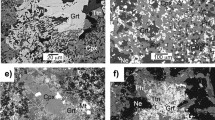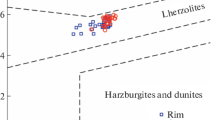Abstract—
The paper presents data on phase relations in garnet-bearing carbonatite from the Tromsø Nappe, Norway. The carbonatite matrix consists of calcite–dolomite carbonate with three generations of garnet inclusions (up to 15–20%). The relics of the primary garnets (Grt1) are depleted (<10–2 wt %) in the rare earth elements (REE). The garnet of the second and third generations (Grt2–3) is anomalously enriched (up to 10–15 wt %) in the light REE (LREE), and the carbonates are depleted in these elements. The distribution of REE between the garnet and carbonate indicates the absence of equilibrium. The melting of the carbonatite at T = 950–1400°C, P = 4.0 GPa showed that the “dry” solidus temperature is 1150°C, and the liquidus temperature is >1300°C. In the experiment with H2O + CO2 fluid, the solidus and liquidus temperatures are ≤950 and 1250°C, respectively. The subsolidus association is calcite, garnet, clinopyroxene, biotite, and accessory minerals: apatite, ilmenite, rutile, and titanite. The garnet and carbonatite melt occur in reaction relationships, as is evident from the garnet zoning with a decrease in the FeO and increase in the MgO, CaO, TiO2, and LREE concentrations. The geological setting, phase relationships, and experimental data indicate that the garnet-bearing carbonatites in the Tromsø area were formed in relation to the carbonatization and melting of upper mantle material at high pressures during the collision of the Baltica and Laurentia plates in the course of the Caledonian orogenesis, with subsequent intrusion and crystallization of silicate–carbonate magmas.








Similar content being viewed by others
REFERENCES
K. Bell and G. R. Tilton, “Nd, Pb and Sr isotopic compositions of east African carbonatites: evidence for mantle mixing and plume inhomogeneity,” J. Petrol. 42, 1927–1945 (2001). https://doi.org/10.1093/petrology
K. Bell and G. R. Tilton, “Probing the mantle: the story from carbonatites,” Eos Trans. Am. Geophys. Union. 83 (273), 276–277 (2002).
K. Bell and A. Simonetti, “Source of parental melts to carbonatites–critical isotopic constraints,” Mineral Petrol. 98, 77–89 (2010). https://doi.org/10.1007/s00710-009-0059-0
O. A. Bogatikov, V. I. Kovalenko, and E. V. Sharkov, Magmatism, Tectonics, and Geodynamics of the Earth (Nauka, Moscow, 2010) [in Russian].
I. Broska, E. J. K. Ravna, P. Vojtko, K. M. Jana, P. Konecny, M. Pentrak, P. Bacik, J. Luptakova, and K. Kullerud, “Oriented inclusions in apatite in a post-UHP fluid–mediated regime (Tromsø Nappe, Norway),” Europ. J. Mineral. 26, 623–634 (2014).
F. Corfu, E. J. K. Ravna, and K. Kullerud, “A late Ordovician U-Pb age for the Tromsø Nappe eclogites, uppermost allochthon of the Scandinavian Caledonides,” Contrib. Mineral. Petrol. 145, 502–513 (2003).
R. Dasgupta, M. M. Hirschmann, W. F. McDonough, M. Spiegelman, and A. C. Withers, “Trace element partitioning between garnet lherzolite and carbonatite at 6.6 and 8.6 GPa with applications to the geochemistry of the mantle and of mantle-derived melts,” Chem. Geol. 262, 57–77 (2009).
N. L. Dobretsov, D. A. Zedgenizov, and K. D. Litasov, “Evidence for and consequences of the “hot” subduction model,” Dokl. Earth Sci. 462 (1), 517–521 (2015).
K. Fassmer, I. Martinet, I. Miladinova, P. Sprung, N. Froitzheim, R. O. C. Fonseca, C. Münker, M. Janák, and K. Kullerud, “Lu-Hf geochronology of ultra-high pressure eclogites from the Tromsø–Nappe, Scandinavian Caledonides: evidence for rapid subduction and exhumation,” Int. J. Earth Sci. 109, 1727–1742 (2020).
A. A. Frolov, A. V. Tolstov, and S. V. Belov, Carbonatite Deposits of Russia (NIA–Priroda, Moscow, 2003) [in Russian].
D. G. Gee, H. Fossen, N. Henriksen, and A. K. Higgins, “From the early Paleozoic platforms of Baltica and Laurentia to the Caledonide Orogen of Scandinavia and Greenland,” Episodes 31, 44–51 (2008).
A. V. Girnis, V. K. Bulatov, Y. Lahaye, and G. P. Brey, “Partitioning of trace elements between carbonate–silicate melts and mantle minerals: experiment and petrological consequences,” Petrology 14 (5), 492–514 (2006).
A. V. Girnis, V. K. Bulatov, G. P. Brey, A. Gerdes, and H. E. Hofer, “Trace element partitioning between mantle minerals and silico–carbonate melts at 6–12 GPa and applications to mantle metasomatism and kimberlite genesis,” Lithos 160–161, 183–200 (2013).
N. S. Gorbachev, “Fluid–magma interaction in sulfide–silicate systems,” Int. Geol. Rev. 32 (8), 749–831 (1990).
N. S. Gorbachev and A. V. Kostyuk, “Distribution of rare and rare earth elements between Grt, Cpx and Cb at mantle PT (from experimental data),” Exp. Geochem. 2 (2), 70–72 (2014).
E. S. Izraeli, J. W. Harris, and O. Navon, “Brine inclusions in diamonds: A new upper mantle fluid,” Earth Planet. Sci. Lett. 187, 323–332 (2001).
M. Janák, E. J. K. Ravna, and K. Kullerud, “Constraining peak P–T conditions in UHP eclogites: Calculated phase equilibria in kyanite- and phengite-bearing eclogite of the Tromsø Nappe, Norway,” J Metamorphic Geol. 30, 377–396 (2012).
M. Janák, E. J. Krogh Ravna, K. Kullerud, K. Yoshida, R. Milovský, and T. Hirajima, “Discovery of diamond in the Tromsø Nappe, Scandinavian Caledonides (N. Norway),” J. Metamorph. Geol. 31, 691–703 (2013).
A. V. Korsakov and J. Hermann, “Silicate and carbonate melt inclusions associated with diamonds in deeply subducted carbonate rocks,” Earth Planet. Sci. Lett. 241, 104–118 (2006).
Yu. A. Litvin, Physicochemical Studies of Melting of materials from the Deep Earth (Nauka, Moscow, 1991) [in Russian].
W. F. McDonough and S. Sun “The composition of the Earth,” Chem Geol. 120, 223–253 (1995).
A. L. Perchuk, V. V. Davydova, M. Burchard, W. V. Maresch, H.-P. Schertl, V. O. Yapaskurt, and O. G. Safonov, “Modification of mineral inclusions in garnet under high-pressure conditions: experimental simulation and application to the carbonate–silciate rocks of the Kokchetav massif,” Russ. Geol. Geophys. 50 (12), 1153–1168 (2009).
I. V. Podborodnikov, A. Shatskiy, A. V. Arefiev, and K. D. Litasov, “Phase relations in the system Na2CO3–CaCO3–MgCO3 at 3 GPa with implications for carbonatite genesis and evolution,” Lithos 330–331, 74–89 (2019).
E. J. K. Ravna and M. R. M. Roux, “Metamorphic evolution of the Tønsvika eclogite, Tromsø Nappe—Evidence for a new UHPM province in the Scandinavian Caledonides,” Int. Geol. Rev. 48, 861–881 (2006).
E. J. K. Ravna, K. Kullerud, and E. Ellingsen, “Prograde garnet-bearing ultramafic rocks from the Tromsø Nappe, northern Scandinavian Caledonides,” Lithos 92, 336–356 (2006).
E. J. K. Ravna, D. Zozulya, K. Kullerud, F. Corfu, P. I. Nabelek, M. Janák, T. Slagstad, B. Davidsen, R. S. Selbekk, and H. P. Schertl, “Deep-seated carbonatite intrusion and metasomatism in the UHP Tromsø Nappe, northern Scandinavian Caledonides–a natural example of generation of carbonatite from carbonated eclogite,” J. Petrol. 58, 2403–2428 (2017).
Yu. B. Shapovalov, N. S. Gorbachev, A. V. Kostyuk, and D. M. Sultanov, “Geochemical features of carbonatites of the Fennoscandian Shield,” Dokl. Earth Sci. 463, 833–838 (2015).
E. V. Sharkov, O. A. Bogatikov, and I. S. Krasivskaya, “The role of mantle plumes in the Early Precambrian tectonics of the Eastern Baltic Shield,” Geotectonics 34 (2), 85–105 (2000).
G. J. Simandl, “Geology and market-dependent significance of rare earth element resources,” Mineral. Deposita 49, 889–904 (2014).
G. J. Simandl and S. Paradis, “Carbonatites: related ore deposits, resources, footprint, and exploration methods,” Appl. Earth Sci.: Trans. Inst. Mining Metallurg. 127, 123–152 (2018).
N. V. Sobolev, Deep Inclusions in Kimberlites and Problems of the Upper Mantle Composition (Nauka, Novosibirsk, 1974) [in Russian].
C. Tschegg, T. Ntaflos, V. V. Akinin, and C. Hauzenberger, “Carbonate–rich melt infiltration in peridotite xenoliths from the Eurasian–North American modern plate boundary (Chersky Range, Yakutia),” Contrib. Mineral. Petrol. 164, 441–455 (2012).
P. L. Verplanck, A. N. Mariano, and A. Mariano, “Rare earth element ore geology of carbonatites,” Rev. Econ. Geol. 18 (5), 32 (2016).
Y. Weiss, R. Kessel, W. L. Griffin, I. Kiflawi, O. Klein-BenDavid, D. R. Bell, J. W. Harris, and O. Navon, “A new model for the evolution of diamond-forming fluids: evidence from microinclusion-bearing diamonds from Kankan, Guinea,” Lithos. 112 (2), 660–674 (2009).
D. A. Zedgenizov, A. L. Ragozin, and V. S. Shatsky, “Chloride–carbonate fluid in diamonds from the eclogite xenolith,” Dokl. Earth Sci. 415 (6), 961–964 (2007).
ACKNOWLEDGMENTS
The authors thank V.K. Karandashev (Institute of Problems of Microelectronics and Ultrapure Materials, Russian Academy of Sciences) for fruitful cooperation. E. Ravna (UiT The Arctic University of Norway) and K. Kullerud (Norwegian Mining Museum) are thanked for conducting joint fieldwork and for useful discussions. The authors highly appreciate valuable recommendations and constructive criticism provided by O.G. Safonov.
Funding
This study was carried out under government-financed research project AAAA-A18-118020590140-7 for the Korzhinskii Institute of Experimental Mineralogy, Russian Academy of Sciences, and was supported during its various phases by the Russian Foundation for Basic Research, project nos. 12-05-00777a and 14-04-00752a, and by the Norway–NWRussia Initiation of Project on Alkaline Rocks in 2009–2010.
Author information
Authors and Affiliations
Corresponding authors
Additional information
Translated by E. Kurdyukov
Rights and permissions
About this article
Cite this article
Kostyuk, A.V., Gorbachev, N.S. & Nekrasov, A.N. Petrogenesis of Garnet-Bearing Carbonatite in the Tromsø Nappe, Norway. Geochem. Int. 59, 801–812 (2021). https://doi.org/10.1134/S0016702921080036
Received:
Revised:
Accepted:
Published:
Issue Date:
DOI: https://doi.org/10.1134/S0016702921080036




